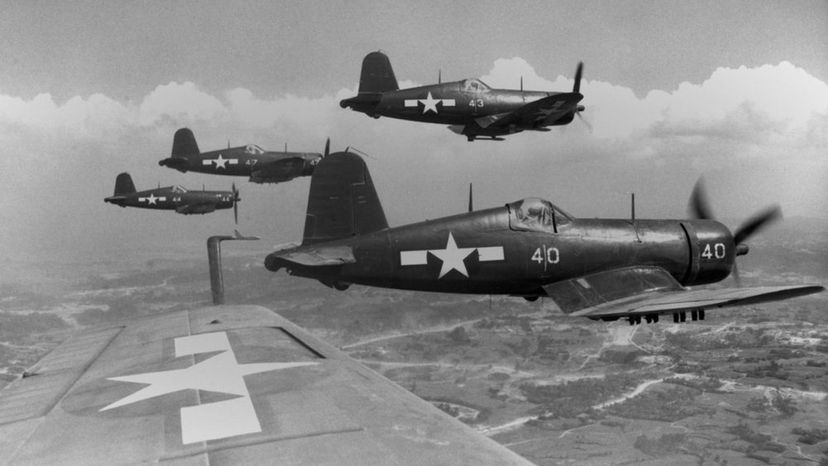
About This Quiz
American forces were island hopping their way towards Tokyo when they came upon a great Japanese outpost in the Pacific. How much do you know about the Battle of Okinawa?Following an important victory at Iwo Jima, Allied forces decided to attack the Okinawa area in April 1945. This battle featured large-scale clashes between Japanese and American combat units.
The weather was fairly dry that year, at least in April. As May approached, heavy rains soaked the islands, creating endless mud pits that made life miserable for soldiers on both sides.
The Allied assault was codenamed Operation Iceberg. The focal point of the operated centered around the island of Okinawa.
Advertisement
The Allies hoped to use Okinawa as a headquarters from which to launch attacks directly on mainland Japan. The Japanese, however, wouldn't give up easily -- the battle raged for 82 days.
As was the local custom, many houses were surrounded by walls. These walls were perfect cover for enemy snipers, who took a great toll on the invading forces.
The Japanese did their best to hold the waters around the islands. They sank 28 American vessels and damaged more than 200 others.
Advertisement
The Japanese called the battle "tetsu no bofu," which means "violent wind of steel." For both sides, Okinawa devolved into one of the bloodiest and ugliest battles of the Pacific War.
Simon Bolivar Buckner Jr. was a general during the battle. In the war's early days, he was in charge of defending the Alaskan islands.
Buckner made a habit of visiting forward observation areas during battles, and he was sometimes less than cautious. Japanese artillery shrapnel struck his torso, and he died in a front-line operating room.
Advertisement
Okinawa is just a little more than 300 miles from the Japanese mainland. Even for World War II-era bombers, this was a short distance, meaning that an Allied base on Okinawa was a critical threat to the Empire.
Japan initiated Operation Ten-Go, in which a small group of Japanese naval vessels tried to beach ships on the island to provide fire support for troops who were on land. The operation was a complete disaster thanks to overwhelming Allied firepower.
There were four functional airfields on the island -- and all of them were heavily defended by anti-aircraft guns and other potent Japanese weapons.
Advertisement
After the battle ended, many Japanese mines remained in the waters around the islands. The navy used Operation Zebra to remove mines.
There were roughly 300,000 locals on the island. By some estimates, once the smoke had cleared, nearly one-third of them were dead.
Many locals resorted to mass suicide, as they were fearful about the atrocities they'd face if the Americans won the battle. Japanese soldiers stoked the fears of these civilians, in part to make them less useful (and more hostile) to the American troops.
Advertisement
Desperate Japanese troops and enraged Americans resorted to base behavior, torturing each other, desecrating corpses and harming civilians. The battle was known more for gore than gallantry.
Okinawa is about 500 square miles, with some hills topping 1,500 feet in height. Its high humidity makes it a miserable place during the summer months.
Life in the mud was unbelievably bad, and motorized vehicles were helpless in the morass. Men lugged supplies by hand, often while facing enemy fire.
Advertisement
More than 12,000 American troops were killed or went missing. Tens of thousands of Japanese soldiers died, too, but no one knows the precise number.
The Japanese launched wave after wave of suicide airplane attacks. These attacks accounted for the vast majority of U.S. naval casualties.
Pyle was a well-known journalist who roamed America, sharing stories about what it meant to live in the United States. During the battle, he was struck by machine-gun fire. He later received a posthumous Purple Heart.
Advertisement
The Yamato was a super battleship, and at the time she was the largest battleship in the world. She carried a crew of more than 2,500 sailors.
The Yamato was sent on a suicide mission -- to defend Okinawa at any cost. She didn't even get close to the island before she was sunk.
Almost completely alone in the sea, Yamato was swarmed by hundreds of Allied warplanes. She suffered at least 11 torpedo strikes and six bomb explosions before she sank.
Advertisement
Months of fierce fighting left Okinawa in ruins. About 90 percent of the island's structures were rubble once combat ended.
The Americans gave Japanese generals a chance to surrender. Ushijima opted to commit suicide by gutting himself with a sword.
Buckner was very close to surviving the epic battle -- there were only four days left when he was killed.
Advertisement
Nearly 2,000 boys under the age of 18 were forced into combat units and made to fight Allied forces. Many of them died via suicide attacks.
The Japanese were loathe to give up ground on Okinawa, and they didn't want to lose the skies, either. They downed nearly 800 Allied warplanes during the battle.
The nearly three-month affair was the bloodiest of the Pacific War. Including civilians and soldiers on both sides, nearly a quarter of a million people died during the ordeal.
Advertisement